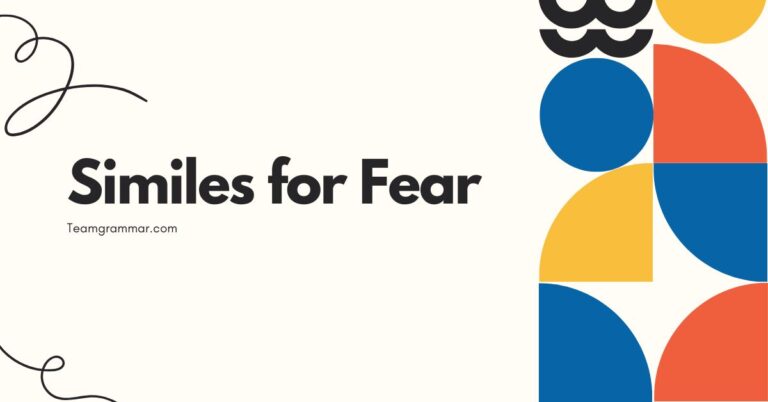41 Similes for Dogs: A Comprehensive Guide
Similes are powerful tools in the English language, allowing us to create vivid comparisons and enhance our descriptions. Understanding similes is crucial for both creative writing and effective communication.
This article focuses on similes specifically related to dogs, exploring their structure, usage, and various examples. Whether you’re a student, writer, or simply a dog lover, this guide will help you master the art of using similes to describe our canine companions in imaginative and engaging ways.
This comprehensive guide provides in-depth explanations, numerous examples, and practical exercises to help you understand and use similes effectively. By the end of this article, you’ll be able to craft compelling descriptions of dogs, enriching your writing and expanding your understanding of figurative language.
Table of Contents
- Definition of Similes
- Structural Breakdown of Similes
- Types of Dog Similes
- Examples of Similes for Dogs
- Usage Rules for Similes
- Common Mistakes When Using Similes
- Practice Exercises
- Advanced Topics in Similes
- Frequently Asked Questions
- Conclusion
Definition of Similes
A simile is a figure of speech that compares two unlike things using the words “like” or “as.” Its primary function is to create a vivid and imaginative comparison, allowing the reader or listener to understand the subject in a new and more engaging way. Similes are essential tools in descriptive writing, adding depth and color to language.
Unlike metaphors, which directly equate two things (e.g., “He is a lion”), similes make an explicit comparison (e.g., “He islikea lion”). This distinction is crucial.
Similes provide a way to draw parallels between seemingly unrelated concepts, enriching the text without asserting a literal equivalence. They are frequently used in literature, poetry, and everyday conversation to enhance understanding and create memorable images.
Similes serve to clarify, emphasize, or beautify descriptions. By using similes, writers can evoke emotions, paint pictures, and make abstract ideas more concrete.
The effectiveness of a simile hinges on the strength of the comparison and its relevance to the subject being described. A well-crafted simile can transform a mundane sentence into a powerful and evocative statement.
Structural Breakdown of Similes
The basic structure of a simile involves three key components: the subject, the linking word (“like” or “as”), and the object of comparison. Understanding each of these components is essential for constructing effective similes.
Thesubjectis the thing being described or compared. This is the focus of the simile.
Thelinking word(“like” or “as”) is the bridge that connects the subject to the object of comparison. It indicates that a comparison is being made, rather than a direct equation.
Theobject of comparisonis the thing to which the subject is being compared. It should share a common characteristic with the subject to create a meaningful comparison.
For example, in the simile “The dog was as fast as lightning,” the dog is the subject, “as” is the linking word, and lightning is the object of comparison. The simile suggests that the dog possesses a speed comparable to that of lightning.
The order of these components is generally consistent, although variations can occur for stylistic effect.
A deeper understanding of simile structure also involves recognizing the implied characteristic being compared. In the example above, the implied characteristic is speed.
Effective similes rely on a shared attribute between the subject and the object of comparison that is readily apparent or easily understood by the audience. This shared attribute is the key to creating a meaningful and impactful comparison.
Types of Dog Similes
Similes for dogs can be categorized based on the aspect of the dog being described. Common categories include appearance, behavior, personality, speed and agility, and sounds.
Each category allows for different types of comparisons, enhancing the richness and variety of descriptions.
Similes Describing Appearance
These similes focus on the physical attributes of the dog, such as its fur, eyes, size, or shape. They help to create a visual image in the reader’s mind.
Similes Describing Behavior
These similes describe the dog’s actions or habits, such as how it plays, eats, or interacts with others. They provide insight into the dog’s temperament and habits.
Similes Describing Personality
These similes focus on the dog’s character traits, such as its loyalty, friendliness, or intelligence. They help to convey the dog’s unique personality.
Similes Describing Speed and Agility
These similes highlight the dog’s physical capabilities, such as its running speed, jumping ability, or overall agility. They emphasize the dog’s athleticism.
Similes Describing Sounds
These similes describe the sounds the dog makes, such as its bark, growl, or whimper. They add an auditory dimension to the description.
Examples of Similes for Dogs
Below are examples of similes categorized by the aspect of the dog they describe. Each category provides a range of similes to illustrate different ways to create vivid and engaging comparisons.
These examples demonstrate how similes can be used to enhance descriptions of dogs in various contexts.
Similes Describing Appearance
These similes focus on the visual characteristics of dogs. They can describe fur color, texture, eye appearance, and overall physical build.
Using these similes helps to create a clear and evocative image of the dog in the reader’s mind.
The following table provides numerous examples of similes that describe a dog’s appearance.
| Simile | Explanation |
|---|---|
| His fur was as white as snow. | Describes the color of the dog’s fur, emphasizing its purity and brightness. |
| Her eyes were like gleaming amber. | Compares the color of the dog’s eyes to a precious gemstone. |
| The dog’s coat was as soft as silk. | Describes the texture of the dog’s fur. |
| He was as big as a small pony. | Compares the dog’s size to that of a pony. |
| Her tail wagged like a metronome. | Describes the rhythmic movement of the dog’s tail. |
| His ears stood up like alert antennas. | Compares the dog’s erect ears to antennas. |
| She was as fluffy as a cotton ball. | Describes the dog’s fur texture, emphasizing its fluffiness. |
| His paws were as big as saucers. | Compares the size of the dog’s paws to saucers. |
| Her nose was as black as coal. | Describes the color of the dog’s nose. |
| He was as skinny as a rail. | Describes the dog’s thin physique. |
| Her fur shone like polished mahogany. | Compares the sheen of the dog’s fur to polished wood. |
| His teeth were as white as pearls. | Describes the color of the dog’s teeth. |
| She was as round as a barrel. | Describes the dog’s stout build. |
| His legs were like sturdy pillars. | Compares the strength and appearance of the dog’s legs to pillars. |
| Her coat was as patchy as a quilt. | Describes the uneven color distribution in the dog’s fur. |
| His eyes were as bright as stars. | Compares the sparkle in the dog’s eyes to stars. |
| She was as sleek as a panther. | Describes the dog’s smooth and graceful appearance. |
| His fur was as coarse as sandpaper. | Describes the rough texture of the dog’s fur. |
| Her build was like a tank. | Compares the dog’s sturdy and robust physique to a tank. |
| He was as shaggy as a rug. | Describes the dog’s long, unkempt fur. |
| Her tail was as bushy as a fox’s. | Compares the fullness of the dog’s tail to that of a fox. |
| His fur was as red as rust. | Describes the color of the dog’s fur. |
| She was as small as a teacup. | Describes the dog’s tiny size. |
| His ears were as floppy as rags. | Describes the limpness of the dog’s ears. |
| Her coat was as golden as the sun. | Describes the color of the dog’s coat. |
| He was as muscular as a bulldog. | Compares the dog’s muscular build to that of a bulldog. |
| Her fur was like a velvet curtain. | Describes the soft and luxurious texture of the dog’s fur. |
Similes Describing Behavior
These similes focus on how dogs act in different situations. They can describe how a dog plays, eats, sleeps, or interacts with people and other animals.
These similes provide insights into a dog’s habits and tendencies.
The following table provides examples of similes describing dog behaviors.
| Simile | Explanation |
|---|---|
| He eats like a vacuum cleaner. | Describes the dog’s rapid and thorough eating habits. |
| She sleeps like a log. | Describes the dog’s deep and undisturbed sleep. |
| He plays fetch like a tireless machine. | Describes the dog’s endless energy and enthusiasm for playing fetch. |
| She greets visitors like a furry tornado. | Describes the dog’s energetic and overwhelming greetings. |
| He barks at squirrels like a seasoned guard. | Describes the dog’s vigilant barking at squirrels. |
| She follows her owner like a shadow. | Describes the dog’s constant and loyal following. |
| He begs for treats like a professional. | Describes the dog’s persistent and skilled begging. |
| She digs in the garden like an archaeologist. | Describes the dog’s enthusiastic and persistent digging. |
| He chases his tail like a dizzy dancer. | Describes the dog’s amusing and circular tail-chasing. |
| She chews on bones like a determined sculptor. | Describes the dog’s focused and thorough chewing. |
| He wags his tail like a happy pendulum. | Describes the rhythmic and joyful wagging of the dog’s tail. |
| She nudges her owner like a gentle reminder. | Describes the dog’s soft and affectionate nudging behavior. |
| He guards the house like a vigilant sentinel. | Describes the dog’s protective and watchful behavior. |
| She sniffs the ground like a detective on a case. | Describes the dog’s thorough and focused sniffing. |
| He jumps for joy like a triumphant athlete. | Describes the dog’s exuberant jumping behavior. |
| She whimpers like a scolded child. | Describes the dog’s sad and pitiful whimpering. |
| He rolls in the grass like a carefree spirit. | Describes the dog’s joyful and uninhibited rolling. |
| She drinks water like a desert traveler. | Describes the dog’s eager and rapid drinking. |
| He marks his territory like a possessive landlord. | Describes the dog’s territorial marking behavior. |
| She hides her toys like a secretive squirrel. | Describes the dog’s habit of concealing its toys. |
| He barks at the mailman like a furious warrior. | Describes the dog’s aggressive barking at the mailman. |
| She cuddles like a warm blanket. | Describes the dog’s comforting and affectionate cuddling. |
| He follows commands like a well-trained soldier. | Describes the dog’s obedient and precise following of commands. |
| She licks faces like a slobbery painter. | Describes the dog’s enthusiastic face-licking. |
| He scratches at the door like a desperate escapee. | Describes the dog’s persistent scratching at the door. |
| She watches TV like a captivated audience. | Describes the dog’s attentive and focused watching of television. |
| He howls at the moon like a lonely wolf. | Describes the dog’s mournful howling. |
Similes Describing Personality
These similes highlight the character traits and temperament of dogs. They can describe a dog’s loyalty, friendliness, intelligence, or any other aspect of its personality.
Using these similes helps to convey the unique essence of a dog’s character.
The following table provides examples of similes that describe a dog’s personality.
| Simile | Explanation |
|---|---|
| He is as loyal as a knight. | Describes the dog’s unwavering loyalty. |
| She is as friendly as a golden retriever. | Compares the dog’s friendliness to that of a golden retriever, known for their amiable nature. |
| He is as intelligent as a border collie. | Compares the dog’s intelligence to that of a border collie, known for their high intellect. |
| She is as brave as a lion. | Describes the dog’s courage and fearlessness. |
| He is as playful as a puppy. | Describes the dog’s energetic and joyful playfulness. |
| She is as gentle as a lamb. | Describes the dog’s kind and tender nature. |
| He is as stubborn as a mule. | Describes the dog’s obstinate and unyielding nature. |
| She is as curious as a cat. | Describes the dog’s inquisitive and investigative nature. |
| He is as protective as a bodyguard. | Describes the dog’s guarding and defensive behavior. |
| She is as affectionate as a kitten. | Describes the dog’s loving and tender behavior. |
| He is as goofy as a clown. | Describes the dog’s silly and amusing behavior. |
| She is as patient as a saint. | Describes the dog’s calm and tolerant demeanor. |
| He is as energetic as a racehorse. | Describes the dog’s boundless energy and enthusiasm. |
| She is as sweet as honey. | Describes the dog’s kind and pleasant disposition. |
| He is as cautious as a spy. | Describes the dog’s careful and observant nature. |
| She is as trusting as a child. | Describes the dog’s innocent and unquestioning nature. |
| He is as determined as a marathon runner. | Describes the dog’s persistent and unwavering determination. |
| She is as wise as an old owl. | Describes the dog’s perceived wisdom and understanding. |
| He is as mischievous as a gremlin. | Describes the dog’s playful and sometimes naughty behavior. |
| She is as comforting as a warm fire. | Describes the dog’s soothing and reassuring presence. |
| He is as dependable as sunrise. | Describes the dog’s reliable and consistent nature. |
| She is as graceful as a ballerina. | Describes the dog’s elegant and fluid movements. |
| He is as resilient as a weed. | Describes the dog’s ability to bounce back from adversity. |
| She is as charming as a diplomat. | Describes the dog’s captivating and persuasive nature. |
| He is as sensitive as a poet. | Describes the dog’s perceptive and empathetic nature. |
| She is as adaptable as a chameleon. | Describes the dog’s ability to adjust to different situations. |
| He is as diligent as a worker bee. | Describes the dog’s hardworking and conscientious nature. |
Similes Describing Speed and Agility
These similes focus on a dog’s physical capabilities, particularly their speed and agility. They often compare the dog to fast animals or objects to emphasize their athleticism.
These similes create a dynamic and impressive image of the dog’s physical prowess.
The following table provides examples of similes that describe a dog’s speed and agility.
| Simile | Explanation |
|---|---|
| He runs as fast as a cheetah. | Compares the dog’s running speed to that of a cheetah, known for its exceptional speed. |
| She jumps as high as a kangaroo. | Compares the dog’s jumping ability to that of a kangaroo. |
| He moves as quickly as a dart. | Describes the dog’s swift and precise movements. |
| She weaves through obstacles like a slalom skier. | Describes the dog’s agility and skill in navigating obstacles. |
| He leaps over fences like an Olympic hurdler. | Describes the dog’s impressive jumping ability. |
| She sprints across the field like a bolt of lightning. | Describes the dog’s incredible speed. |
| He dodges and weaves like a seasoned boxer. | Describes the dog’s agility and quick reflexes. |
| She climbs the hill like a mountain goat. | Describes the dog’s skill and ease in climbing. |
| He navigates the forest like a seasoned tracker. | Describes the dog’s skill and agility in moving through the forest. |
| She darts through the crowd like a hummingbird. | Describes the dog’s quick and agile movements through a crowd. |
| He bounds across the yard like a playful deer. | Describes the dog’s energetic and graceful movements. |
| She flies through the air like a feathered missile. | Describes the dog’s impressive jumping or leaping ability. |
| He races down the street like a runaway train. | Describes the dog’s unstoppable speed. |
| She prances around like a show pony. | Describes the dog’s elegant and spirited movements. |
| He scurries under the table like a frightened mouse. | Describes the dog’s quick and agile movements in a confined space. |
| She springs into action like a coiled snake. | Describes the dog’s sudden and powerful movements. |
| He zips around the park like a caffeinated squirrel. | Describes the dog’s hyperactive and energetic movements. |
| She charges forward like a battering ram. | Describes the dog’s forceful and determined movements. |
| He maneuvers through the bushes like a jungle cat. | Describes the dog’s agility and skill in navigating dense vegetation. |
| She leaps and twirls like a figure skater. | Describes the dog’s graceful and athletic movements. |
| He dashes across the lawn like a roadrunner. | Describes the dog’s quick and nimble movements. |
| She glides over the water like a swan. | Describes the dog’s graceful swimming ability. |
| He climbs the stairs like an agile acrobat. | Describes the dog’s skill and ease in climbing stairs. |
| She dances around like a whirling dervish. | Describes the dog’s energetic and spinning movements. |
| He pounces on his toy like a predator. | Describes the dog’s quick and focused movements when playing. |
| She bounds over logs like a skilled parkour artist. | Describes the dog’s impressive jumping and agility. |
| He accelerates like a sports car. | Describes the dog’s rapid increase in speed. |
Similes Describing Sounds
These similes focus on the sounds that dogs make, such as barking, growling, whimpering, or howling. They add an auditory dimension to the description, enhancing the reader’s sensory experience.
These similes help to convey the emotional context of the sounds.
The following table provides examples of similes that describe the sounds a dog makes.
| Simile | Explanation |
|---|---|
| His bark is as loud as a thunderclap. | Describes the volume and intensity of the dog’s bark. |
| Her growl is as menacing as a lion’s roar. | Describes the threatening and intimidating sound of the dog’s growl. |
| His whimper is as soft as a baby’s cry. | Describes the gentle and pitiful sound of the dog’s whimper. |
| Her howl is as mournful as a lonely wolf’s. | Describes the sad and prolonged sound of the dog’s howl. |
| His bark is as sharp as a gunshot. | Describes the sudden and piercing sound of the dog’s bark. |
| Her whine is as persistent as a dripping faucet. | Describes the annoying and constant sound of the dog’s whine. |
| His snore is as loud as a chainsaw. | Describes the noisy and raucous sound of the dog’s snoring. |
| Her bark is as playful as a child’s giggle. | Describes the light and joyful sound of the dog’s bark. |
| His growl is as deep as a rumbling earthquake. | Describes the low and ominous sound of the dog’s growl. |
| Her whimper is as heart-wrenching as a sad song. | Describes the emotionally affecting sound of the dog’s whimper. |
| His howl is as haunting as a ghost’s wail. | Describes the eerie and unsettling sound of the dog’s howl. |
| Her bark is as shrill as an alarm. | Describes the high-pitched and attention-grabbing sound of the dog’s bark. |
| His panting is as heavy as an athlete’s breath. | Describes the labored and audible sound of the dog’s panting. |
| Her yelp is as sudden as a popped balloon. | Describes the sharp and abrupt sound of the dog’s yelp. |
| His bark echoes like a cannon blast. | Describes the resounding and powerful sound of the dog’s bark. |
| Her purr is as soothing as a lullaby. | Describes the gentle and comforting sound of the dog’s purr-like rumble. |
| His bark is as grating as nails on a chalkboard. | Describes the irritating and unpleasant sound of the dog’s bark. |
| Her growl is as guttural as a monster’s voice. | Describes the deep and throaty sound of the dog’s growl. |
| His whimper is as fragile as glass. | Describes the delicate and tender sound of the dog’s whimper. |
| Her howl rises and falls like a siren. | Describes the wavering and attention-grabbing sound of the dog’s howl. |
| His bark is as commanding as a drill sergeant’s voice. | Describes the authoritative and forceful sound of the dog’s bark. |
| Her snuffle is as quiet as a whisper. | Describes the soft and subtle sound of the dog’s snuffling. |
| His bark is as deafening as a rock concert. | Describes the extremely loud and overwhelming sound of the dog’s bark. |
| Her growl rumbles like distant thunder. | Describes the low and ominous sound of the dog’s growl. |
| His whimper tugs at your heartstrings like a sad violin. | Describes the emotionally affecting sound of the dog’s whimper. |
| Her howl carries across the night like a lonely cry. | Describes the far-reaching and poignant sound of the dog’s howl. |
| His bark is as cheerful as a ringing bell. | Describes the bright and uplifting sound of the dog’s bark. |
Usage Rules for Similes
Using similes effectively involves adhering to certain rules to ensure clarity and impact. These rules cover the choice of comparison, the use of “like” or “as,” and the overall context in which the simile is used.
Choose Relevant Comparisons:The object of comparison should share a clear and understandable attribute with the subject. The comparison should make sense and enhance the reader’s understanding.
Avoid comparisons that are too obscure or far-fetched, as they can confuse or distract the reader.
Use “Like” or “As” Correctly:Similes use the words “like” or “as” to make the comparison. Ensure that you use these words correctly to indicate that you are drawing a parallel rather than stating a direct equivalence.
For example, “He runslikethe wind” is correct, while “He is the wind” is a metaphor.
Maintain Clarity:The purpose of a simile is to clarify or enhance a description. Ensure that the simile adds to the reader’s understanding rather than obscuring it.
Avoid using overly complex or convoluted similes that are difficult to interpret.
Consider Context:The effectiveness of a simile depends on its context. Consider the tone, style, and audience when choosing a simile.
A simile that works well in one context may be inappropriate in another. Tailor your similes to suit the specific needs of your writing or conversation.
Avoid Clichés:While some common similes can be effective, overuse can make your writing seem unoriginal. Strive to create fresh and imaginative comparisons that set your writing apart.
Avoid relying on clichés such as “as brave as a lion” or “as fast as lightning,” unless you can use them in a novel or ironic way.
Ensure Grammatical Accuracy:Make sure that your similes are grammatically correct. The comparison should be structurally sound and free of grammatical errors.
Pay attention to subject-verb agreement and the correct use of modifiers.
Use Sparingly:While similes can enhance your writing, overuse can make it seem forced or artificial. Use similes judiciously, selecting them carefully to create the greatest impact.
Balance the use of similes with other descriptive techniques to create a well-rounded and engaging text.
Common Mistakes When Using Similes
Several common mistakes can undermine the effectiveness of similes. Understanding these errors and how to avoid them is crucial for using similes correctly.
Incorrect Comparison: One of the most common mistakes is choosing an object of comparison that does not share a relevant attribute with the subject. For example, “The dog was as tall as a tree” is not an effective simile because height is not a characteristic typically associated with dogs.
Misusing “Like” and “As”: Confusing similes with metaphors can lead to incorrect usage of “like” and “as.” Remember that similes use these words to make a comparison, while metaphors directly equate two things. For instance, saying “The dog is a shadow” is a metaphor, not a simile.
Overusing Clichés: Relying too heavily on clichés can make your writing seem unoriginal and predictable. Avoid using tired and overused similes such as “as happy as a clam” or “as quiet as a mouse.” Instead, strive to create fresh and imaginative comparisons.
Creating Confusing Comparisons:The purpose of a simile is to clarify or enhance a description. Avoid using overly complex or convoluted similes that are difficult to understand.
The comparison should be clear and straightforward.
Ignoring Context:Using a simile that is inappropriate for the context can detract from your writing. Consider the tone, style, and audience when choosing a simile.
A simile that works well in one situation may be unsuitable in another.
Grammatical Errors:Ensure that your similes are grammatically correct. Pay attention to subject-verb agreement and the correct use of modifiers.
A grammatically incorrect simile can be confusing or distracting.
Here are some examples of common mistakes and their corrections:
| Incorrect | Correct | Explanation |
|---|---|---|
| The dog was tall like a building. | The dog was as tall as a small pony. | Buildings are not a typical comparison for a dog’s height, while a pony is more relevant. |
| He is shadow. | He is like a shadow. | The first example is a metaphor, while the second is a simile using “like.” |
| She was as happy as a clam. | She was as happy as a dog with a bone. | The first example is a cliché, while the second is a more original comparison. |
| The dog’s bark was loud like the concept of existentialism. | The dog’s bark was as loud as a thunderclap. | The first example is confusing, while the second is clear and understandable. |
| He runs fast like. | He runs as fast as a cheetah. | The first example is grammatically incomplete, while the second is grammatically correct. |
Practice Exercises
Test your understanding of similes for dogs with the following exercises. Each exercise focuses on a different aspect of simile usage, from identifying similes to creating your own.
Exercise 1: Identifying Similes
Identify the similes in the following sentences.
| Question | Answer |
|---|---|
| 1. The dog’s fur was as soft as a cloud. | as soft as a cloud |
| 2. He ran like the wind | like the wind |
| 3. Her eyes were like sparkling jewels. | like sparkling jewels |
| 4. The puppy is a ball of energy. | (This sentence contains a metaphor, not a simile) |
| 5. He eats like a horse. | like a horse |
Exercise 2: Completing Similes
Complete the following similes with an appropriate comparison.
| Question | Answer |
|---|---|
| 1. The dog was as loyal as _____. | a knight |
| 2. She slept like _____. | a log |
| 3. He barked as loud as _____. | thunder |
| 4. Her tail wagged like _____. | a metronome |
| 5. He was as playful as _____. | a puppy |
Exercise 3: Creating Similes
Create your own similes to describe the following aspects of a dog.
| Aspect | Example Answer |
|---|---|
| 1. The dog’s size | He was as big as a small bear. |
| 2. The dog’s speed | He ran as fast as a race car. |
| 3. The dog’s personality | She was as gentle as a lamb. |
| 4. The dog’s bark | His bark was as sharp as a whip. |
| 5. The dog’s fur | Her fur was as shiny as polished silver. |
Exercise 4: Correcting Incorrect Similes
Identify and correct the incorrect similes in the following sentences.
| Question | Answer | Corrected |
|---|---|---|
| 1. The dog was as heavy as the sky. | Incorrect comparison | The dog was as heavy as a bag of rocks. |
| 2. He is a sun. | Metaphor used as a simile | He is like the sun, always bringing warmth. |
| 3. She was as happy as a rock. | Inappropriate comparison | She was as happy as a kid in a candy store. |
| 4. His bark was loud like space. | Unclear comparison | His bark was as loud as a siren. |
| 5. The dog runs fast like. | Grammatically incorrect | The dog runs as fast as a greyhound. |
Advanced Topics in Similes
Beyond the basics, similes can be explored in more depth to enhance their impact and sophistication. This involves understanding how similes interact with other literary devices, how they can be used in extended metaphors, and how cultural context can influence their interpretation.
Similes and Metaphors:While similes make explicit comparisons using “like” or “as,” metaphors imply a comparison by stating that one thing is another. Advanced use involves blending similes and metaphors to create layered meanings.
For example, a writer might start with a simile (“He was like a lion”) and then develop it into a metaphor (“His roar echoed through the room”).
Similes in Extended Metaphors:An extended metaphor is a metaphor that is developed over several lines or even an entire work. Similes can be used to introduce and support an extended metaphor, providing concrete comparisons that build towards a more abstract or complex idea.
For instance, a poem might use similes to compare different aspects of a dog’s life to elements of human experience, creating an extended metaphor about loyalty and companionship.
Cultural Context:The interpretation of similes can be influenced by cultural context. Comparisons that are meaningful in one culture may not resonate in another.
Understanding the cultural background of your audience is essential for choosing similes that will be effective and appropriate. For example, a simile comparing a dog to a revered animal might be well-received in one culture but offensive in another.
Originality and Creativity:The most effective similes are those that are fresh and original. Avoid relying on clichés and strive to create comparisons that are surprising and insightful.
Experiment with different types of comparisons and consider the specific qualities of the subject you are describing. The goal is to create similes that are both meaningful and memorable.
Combining Similes with Other Literary Devices: Similes can be combined with other literary devices such as personification, hyperbole, and irony to create more complex and nuanced effects. For example, a writer might use personification to give a dog human-like qualities and then use similes to compare those qualities to familiar objects or experiences.
Using Similes to Evoke Emotion:Similes can be powerful tools for evoking emotion in the reader. By choosing comparisons that are emotionally resonant, writers can create a deeper connection with their audience.
For example, a simile comparing a dog’s loyalty to the unwavering support of a friend can evoke feelings of warmth and affection.
Frequently Asked Questions
Conclusion
Similes are invaluable tools for enriching language and enhancing descriptions, particularly when writing about dogs. By understanding the structure, types, and usage rules of similes, writers can craft vivid and engaging comparisons that bring their subjects to life.
Avoiding common mistakes and practicing regularly will further refine your ability to use similes effectively.
From describing a dog’s appearance to capturing its personality, similes offer endless possibilities for creative expression. Whether you’re a student, writer, or simply a dog lover, mastering the art of simile will deepen your appreciation for language and improve your ability to communicate in imaginative and compelling ways.
So go forth, and use similes to paint a thousand words with the stroke of a few!







